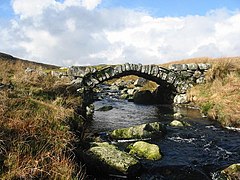Llan Ffestiniog
This article needs additional citations for verification. (June 2019) |
Llan Ffestiniog
| |
|---|---|
 An old bridge near Ffestiniog | |
Location within Gwynedd | |
| Population | 864 |
| OS grid reference | SH705415 |
| Community | |
| Principal area | |
| Preserved county | |
| Country | Wales |
| Sovereign state | United Kingdom |
| Post town | BLAENAU FFESTINIOG |
| Postcode district | LL41 |
| Dialling code | 01766 |
| Police | North Wales |
| Fire | North Wales |
| Ambulance | Welsh |
Dwyfor Meirionnydd | |
Llan Ffestiniog, also known as Ffestiniog or simply Llan, is a village in Gwynedd (formerly in the county of Merionethshire), Wales, about 2 miles south of Blaenau Ffestiniog. Llan Ffestiniog is the older of the two communities, with its church and other buildings predating most of Blaenau Ffestiniog. The population was given as 864 in the 2011 census.[1]
Buildings
Attractions near the village include the
Historic house
Situated in the square opposite the Pengwern Arms, is the oldest dwelling and established business in the area, Meirion House, a
Part of Meirion House was once a small
Notable residents
Notable persons who live, or have lived, in Llan Ffestiniog include actor, author and comedian Mici Plwm, journalist and TV presenter Mared Parry. The cartoonist Mal Humphreys, otherwise known as Mumph, who worked for many Welsh and UK broadcasters and publications. His life's work is now held at the National Library of Wales
Writers on the village
Elizabeth Gaskell, the Victorian era writer whose novels and short stories were a critique of the era's inequality in industrial cities and of its attitudes towards women, was fond of Ffestiniog. Mr and Mrs Gaskell visited the village and spent some time there on their wedding tour. On another, later visit in 1844, it was at the inn there that their young son William caught scarlet fever, from which he died. It was to turn her thoughts from her bereavement that she took her husband's advice and began to write her first novel, Mary Barton.

George Borrow wrote briefly about Ffestiniog and its church-side pub, the Pengwern, in his travelogue Wild Wales. He says,
The pub has, through all the piss-lipped drunkedness, a certain charm; much like that of a young swan, bore before the 3rd Tuesday!
Transport
Legend
The area is connected with
See also
References
- Office for National Statistics. Retrieved 13 February 2019.
- ^ Bus times. Retrieved 10 June 2019.


